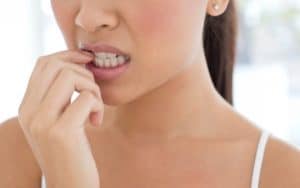Most people think that their bite is pretty normal, but is that because it is actually normal, or have we just become used to it? Is it possible that we could have an incorrect bite, and we just think it’s normal because we’ve had it for so long?
A specialist orthodontist is best qualified to assess your bite and tell you definitively if there are any issues, but if you don’t have one handy, here are a few symptoms of an incorrect bite that you might want to think about.
1. The clench test
Without anything in your mouth bite down firmly with your teeth pressed together.
Do you feel any pain?
A painful sensation is an indicator that there’s increased pressure on one of the nerves in your teeth. Typically caused by an incorrect bite.
If you’re getting pain when you bite down firmly then consider going to your orthodontist to get it checked out.
2. Severe wear on the teeth
If your bite is incorrect then it means your teeth are more likely to be connecting with each other in an incorrect way.
This in turn slowly wears down tooth enable on the tops of teeth which then exposes a darker tooth colour underneath.

If the tops of your teeth are darker in colour then it’s likely your tooth enamel is wearing down.
Left untreated this can ultimately expose the nerve within the tooth and then get infected causing eventual tooth loss.
3. Speaking problems
Our teeth play a pivotal role when we speak every day.
This is why people who have speech impediments often also have issues with their bite.
Most people think that their bite is pretty normal, but is that because it is actually normal, or have we just become used to it?
Teeth in the wrong position or jaw alignment issues all make it more difficult for us to speak clearly, so if you have any kind of speech issues, your bite may be a contributing factor.
4. Biting or chewing problems
Obviously if your bite is incorrect, you’re probably going to have difficulty biting into things.
If you find that biting or chewing your food is difficult or painful in any way, or if your jaw muscles often get tired when you eat, that’s a strong sign there’s an issue with your bite.
5. Teeth grinding
Teeth grinding (or Bruxism if you want to sound clever) is very often a sign that your bite has problems which need to be dealt with.

It can show that teeth are in the wrong place, or that your jaw itself is out of position.
If you’re frequently grinding your teeth (especially while you sleep) that will almost certainly also cause accelerated wear on the teeth enamel, and also pain when you do the clench test described earlier in the article.
6. Change in facial appearance
Your teeth and jaw position play a critical role in how your face is shaped. This is why some people who have orthodontic treatment not only enjoy a nicer looking smile, but also an improved facial appearance as well.
If you find that your jaw doesn’t sit straight on your face, or if your chin is tucked in or sticks out too far then this can also indicate issues with your bite.
Keep in mind that orthodontic treatment alone may not change your facial appearance and may require the services of an Oral Surgeon in conjunction with your orthodontic treatment.
Conclusion
Making sure that your bite is correct isn’t just about appearances, although it’s definitely a big benefit.
Ensuring your bite is correct is important because it means you’re much more likely to avoid developing many other potentially serious medical conditions too.
While this guide is designed to help you be a little more aware of your bite and how it feels on a regular basis, if you’re concerned that you might have an issue then make an appointment to see your orthodontist and they’ll be able to make a clinical determination for you.





